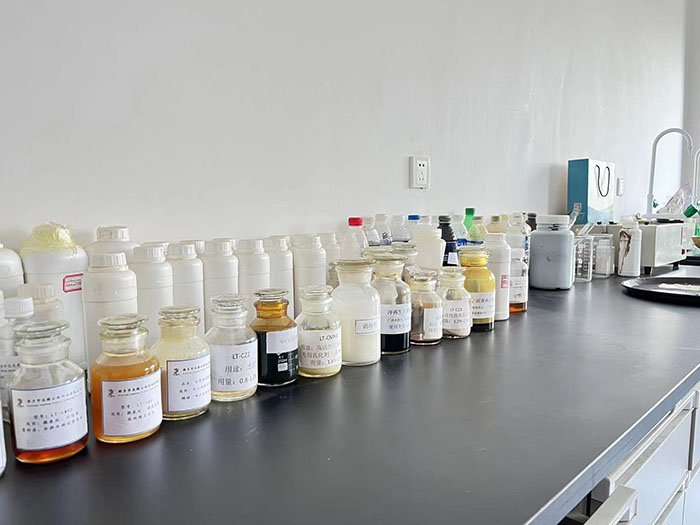The formula ratio of asphalt emulsifier is scientifically determined by comprehensively considering factors such as emulsifier performance, asphalt properties, construction requirements, and environmental conditions. Its core goal is to achieve stable emulsification, controllable demulsification, and good construction performance. The following are the specific steps and key factors for determining:
1. Basic formula composition
Emulsifier formulations typically contain the following ingredients, with proportions that need to be dynamically adjusted:
Main emulsifier (30%~70%): determines the charge type (cation/anion/nonionic) and demulsification rate.
Cationic type (such as quaternary ammonium salt): commonly used in a proportion of 1% to 3% (by weight of asphalt), suitable for acidic stones, and can crack quickly to slowly.
Anionic type (such as fatty acid soap): proportion 1%~2.5%, suitable for alkaline stone materials, mostly slow cracking.
Non ionic type (such as OP-10): often compounded with ionic type (0.5%~1.5%) to improve stability.
Co emulsifiers (10%~30%): such as alcohols (ethanol, isopropanol) or acids (hydrochloric acid, phosphoric acid), regulate HLB value (hydrophilic oleophilic balance).
Stabilizers (0.1%~1%): such as cellulose and calcium chloride, to prevent storage delamination.
Water (balance): accounts for 30%~60% of the total formula, and the pH value needs to be adjusted to 2-6 (cationic) or 8-12 (anionic).
2. Key determining factors
(1) Asphalt properties
Penetration and softening point: High viscosity asphalt (such as No. 70) requires an increase in emulsifier dosage (2%~3%), while low viscosity asphalt (such as No. 130) can be reduced to 1%~1.5%.
Chemical components: High aromatic asphalt is prone to emulsification and can reduce the proportion of emulsifiers; Asphalt with high wax content requires enhanced emulsification (such as compounding with non-ionic agents).
(2) Requirement for demulsification speed
Fast cracking type: high concentration cationic agent (such as 3% alkyl dimethyl tertiary amine)+strong acid (pH=2-3).
Slow cracking type: non-ionic agent compound (such as 1% OP-10+1% quaternary ammonium salt)+weak acid (pH=4-5).
(3) Characteristics of stone materials
Acidic stone (granite): cationic emulsifiers must be used (based on the principle of charge adsorption).
Alkaline stone (limestone): Anionic or non-ionic is more economical.
(4) Environmental temperature
Low temperature construction (<10 ℃): It is necessary to add antifreeze agents (such as ethylene glycol) and increase the activity of emulsifiers (by 1% to 2%).
High temperature construction (>30 ℃): Reduce the amount of emulsifier (to avoid rapid emulsification), and add a demulsifier (such as 0.1% polyvinyl alcohol).
3. Formula development process
(1) Laboratory trial
Shear emulsify according to the preliminary ratio (such as asphalt: water: emulsifier=60:39:1), observe stability (no delamination after 24 hours), particle size (microscopic detection, target 1-5 μ m).
(2) Performance testing
Storage stability (EN 12847 standard): ≤ 1% precipitation (24h, 25 ℃).
Demulsification time: determined by mixing test or electronic tension meter.
Adhesive strength: Use a tensile tester to test the adhesion with the stone material.
(3) On site adjustment
Adjust the pH value or proportion of additives according to the construction equipment (colloid mill efficiency), base humidity, etc.
4. Typical formula examples
(1) Cationic fast cracking emulsified asphalt
Asphalt (60%), water (37.5%), alkyl dimethyl tertiary amine (2%), hydrochloric acid (0.5%, pH adjusted to 2-3).
(2) Anionic slow cracking emulsified asphalt
Asphalt (55%), water (43%), fatty acid soap (1.5%), sodium hydroxide (0.5%, pH adjusted to 10-11), calcium chloride (0.1%).
5. Precautions
Synergistic effect of compounding: Non ionic+cationic combination can broaden temperature adaptability (such as compounding OP-10 with quaternary ammonium salt in a ratio of 1:2).
Environmental requirements: Avoid using restricted substances such as alkylphenol polyoxyethylene ether (APEO).
The actual formula needs to be optimized through experimental iterations, and ultimately the balance between stability, demulsification speed, and cost should be taken into account.


